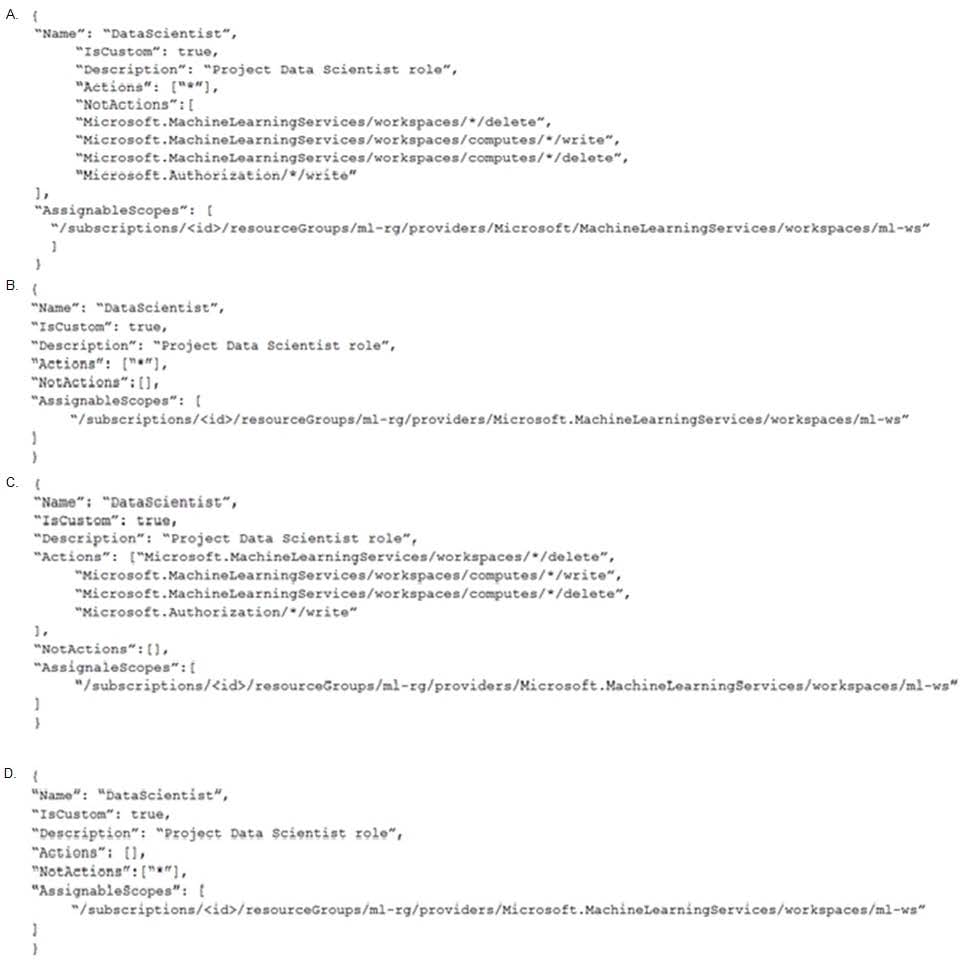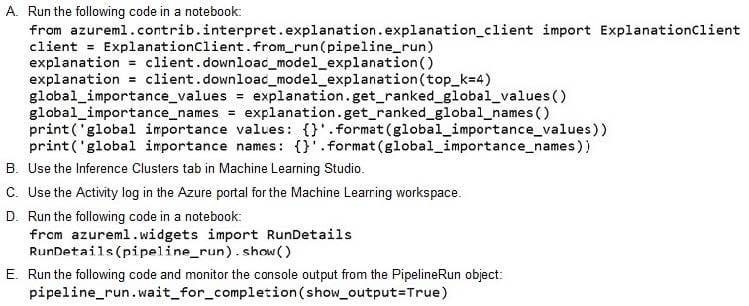Exam Details
Exam Code
:DP-100Exam Name
:Designing and Implementing a Data Science Solution on AzureCertification
:Microsoft CertificationsVendor
:MicrosoftTotal Questions
:564 Q&AsLast Updated
:Aug 07, 2025
Microsoft Microsoft Certifications DP-100 Questions & Answers
-
Question 341:
You train a machine learning model.
You must deploy the model as a real-time inference service for testing. The service requires low CPU utilization and less than 48 MB of RAM. The compute target for the deployed service must initialize automatically while minimizing cost and administrative overhead.
Which compute target should you use?
A. Azure Container Instance (ACI)
B. attached Azure Databricks cluster
C. Azure Kubernetes Service (AKS) inference cluster
D. Azure Machine Learning compute cluster
-
Question 342:
You create an Azure Machine Learning workspace.
You must create a custom role named DataScientist that meets the following requirements:
1.
Role members must not be able to delete the workspace.
2.
Role members must not be able to create, update, or delete compute resource in the workspace.
3.
Role members must not be able to add new users to the workspace.
You need to create a JSON file for the DataScientist role in the Azure Machine Learning workspace.
The custom role must enforce the restrictions specified by the IT Operations team.
Which JSON code segment should you use?

A. Option A
B. Option B
C. Option C
D. Option D
-
Question 343:
Note: This question is part of a series of questions that present the same scenario. Each question in the series contains a unique solution that might meet the stated goals. Some question sets might have more than one correct solution, while
others might not have a correct solution.
After you answer a question in this section, you will NOT be able to return to it. As a result, these questions will not appear in the review screen.
An IT department creates the following Azure resource groups and resources:

The IT department creates an Azure Kubernetes Service (AKS)-based inference compute target named aks-cluster in the Azure Machine Learning workspace.
You have a Microsoft Surface Book computer with a GPU. Python 3.6 and Visual Studio Code are installed.
You need to run a script that trains a deep neural network (DNN) model and logs the loss and accuracy metrics.
Solution: Install the Azure ML SDK on the Surface Book. Run Python code to connect to the workspace and then run the training script as an experiment on local compute.
Does the solution meet the goal?
A. Yes
B. No
-
Question 344:
Note: This question is part of a series of questions that present the same scenario. Each question in the series contains a unique solution that might meet the stated goals. Some question sets might have more than one correct solution, while
others might not have a correct solution.
After you answer a question in this section, you will NOT be able to return to it. As a result, these questions will not appear in the review screen.
An IT department creates the following Azure resource groups and resources:

The IT department creates an Azure Kubernetes Service (AKS)-based inference compute target named aks-cluster in the Azure Machine Learning workspace.
You have a Microsoft Surface Book computer with a GPU. Python 3.6 and Visual Studio Code are installed.
You need to run a script that trains a deep neural network (DNN) model and logs the loss and accuracy metrics.
Solution: Install the Azure ML SDK on the Surface Book. Run Python code to connect to the workspace. Run the training script as an experiment on the aks-cluster compute target.
Does the solution meet the goal?
A. Yes
B. No
-
Question 345:
You train and register a model in your Azure Machine Learning workspace.
You must publish a pipeline that enables client applications to use the model for batch inferencing. You must use a pipeline with a single ParallelRunStep step that runs a Python inferencing script to get predictions from the input data.
You need to create the inferencing script for the ParallelRunStep pipeline step.
Which two functions should you include? Each correct answer presents part of the solution.
NOTE: Each correct selection is worth one point.
A. run(mini_batch)
B. main()
C. batch()
D. init()
E. score(mini_batch)
-
Question 346:
You deploy a model as an Azure Machine Learning real-time web service using the following code.

The deployment fails.
You need to troubleshoot the deployment failure by determining the actions that were performed during deployment and identifying the specific action that failed.
Which code segment should you run?
A. service.get_logs()
B. service.state
C. service.serialize()
D. service.update_deployment_state()
-
Question 347:
Note: This question is part of a series of questions that present the same scenario. Each question in the series contains a unique solution that might meet the stated goals. Some question sets might have more than one correct solution, while
others might not have a correct solution.
After you answer a question in this section, you will NOT be able to return to it. As a result, these questions will not appear in the review screen.
An IT department creates the following Azure resource groups and resources:

The IT department creates an Azure Kubernetes Service (AKS)-based inference compute target named aks-cluster in the Azure Machine Learning workspace.
You have a Microsoft Surface Book computer with a GPU. Python 3.6 and Visual Studio Code are installed.
You need to run a script that trains a deep neural network (DNN) model and logs the loss and accuracy metrics.
Solution: Attach the mlvm virtual machine as a compute target in the Azure Machine Learning workspace. Install the Azure ML SDK on the Surface Book and run Python code to connect to the workspace. Run the training script as an
experiment on the mlvm remote compute resource.
Does the solution meet the goal?
A. Yes
B. No
-
Question 348:
You create a multi-class image classification deep learning model.
You train the model by using PyTorch version 1.2.
You need to ensure that the correct version of PyTorch can be identified for the inferencing environment when the model is deployed.
What should you do?
A. Save the model locally as a.pt file, and deploy the model as a local web service.
B. Deploy the model on computer that is configured to use the default Azure Machine Learning conda environment.
C. Register the model with a .pt file extension and the default version property.
D. Register the model, specifying the model_framework and model_framework_version properties.
-
Question 349:
You create a deep learning model for image recognition on Azure Machine Learning service using GPU- based training.
You must deploy the model to a context that allows for real-time GPU-based inferencing.
You need to configure compute resources for model inferencing.
Which compute type should you use?
A. Azure Container Instance
B. Azure Kubernetes Service
C. Field Programmable Gate Array
D. Machine Learning Compute
-
Question 350:
You create a batch inference pipeline by using the Azure ML SDK. You run the pipeline by using the following code:
from azureml.pipeline.core import Pipeline
from azureml.core.experiment import Experiment
pipeline = Pipeline(workspace=ws, steps=[parallelrun_step]) pipeline_run = Experiment(ws, 'batch_pipeline').submit(pipeline)
You need to monitor the progress of the pipeline execution.
What are two possible ways to achieve this goal? Each correct answer presents a complete solution.
NOTE: Each correct selection is worth one point.

A. Option A
B. Option B
C. Option C
D. Option D
E. Option E
Related Exams:
62-193
Technology Literacy for Educators70-243
Administering and Deploying System Center 2012 Configuration Manager70-355
Universal Windows Platform – App Data, Services, and Coding Patterns77-420
Excel 201377-427
Excel 2013 Expert Part One77-725
Word 2016 Core Document Creation, Collaboration and Communication77-726
Word 2016 Expert Creating Documents for Effective Communication77-727
Excel 2016 Core Data Analysis, Manipulation, and Presentation77-728
Excel 2016 Expert: Interpreting Data for Insights77-731
Outlook 2016 Core Communication, Collaboration and Email Skills
Tips on How to Prepare for the Exams
Nowadays, the certification exams become more and more important and required by more and more enterprises when applying for a job. But how to prepare for the exam effectively? How to prepare for the exam in a short time with less efforts? How to get a ideal result and how to find the most reliable resources? Here on Vcedump.com, you will find all the answers. Vcedump.com provide not only Microsoft exam questions, answers and explanations but also complete assistance on your exam preparation and certification application. If you are confused on your DP-100 exam preparations and Microsoft certification application, do not hesitate to visit our Vcedump.com to find your solutions here.